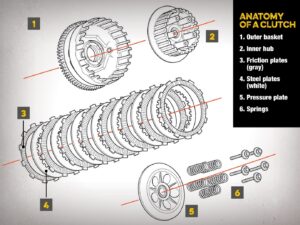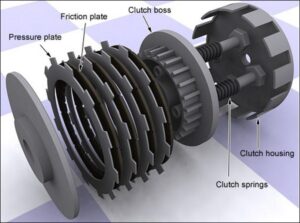What Is Motorcycle clutch plate And types & How It Works ?
In Manual Transmission motorcycle ,the clutch is the component in the engine that and disengages power from the engine to the transmission in order to change gears . in other words it enables the rider to turn on or off power to the rear wheel to change gears.
Components and clutch and their functions
The motorcycle clutch works through a clutch assembly consisting of numerous components including primary driver gear, clutch basket, clutch plate, clutch hub, clutch springs, level, clutch cable and pressure plates.

Functions :
Primary drive – A gear assembly in which power from the engine crankshaft goes out through a smaller gear, Which drives a larger gear in the basket.
Clutch Basket – A basket which contains
The entire assembly, having teeth on its outer surface which are connected to and driven by the primary drive.
Clutch Hub – It is between the basket and the pressure plate, ad is rotates by the main shaft through its centre.
Clutch Plate – There are two types of clutch plates, the drive/friction plate and the driven/steel plate. The drive plate is the interface between the clutch basket and the pressure plate. The driven plate is the interface between the pressure plate and the clutch hub. When they rotate together, power is transferred from the engine to the transmission.
Pressure Plate – Moving part of the clutch assembly that disengages the clutch temporarily disabling power from the engine to the transmission.
Clutch Springs – Short coil that hold the clutch plates through springs tension. The disengaged the pressure plate from the clutch plates.
Clutch Lever – Lever located at the left handlebar of the bike that gives input to the clutch plates.
Cable – Connects the level to the clutch assembly.
Types of clutch
There are two types of clutches – wet and dry
- Wet clutch are used in almost all bikes they are bathed in engine oil, to cool the clutch components, but this causes a fluid drag that saps the engine power.
2.Dry clutches are noisier and have a shorter life due to the absence of oil, but aren’t affected by fluid drag.
Working of a clutch
When the clutch lever is pulled, the clutch springs compress, causing the pressure plate to retract. This separates the friction and steel Plates, and they rotate independently, thus disconnecting the engine from the transmission. Thus, the power to the rear wheel stops, and the gears can be changed. This is how a motorcycle clutch works.
What is a single plate clutch?
In our vehicle, the clutch is located between the engine and gearbox when the clutch is engaged lever is depressed or released the rotational motion transmits from the engine shaft to the gear shaft. Then gears transmits the power to the propeller and then wheels. When we push the clutch pedal pull the lever, the clutch disengages, this stops the motion transmission from one shaft to the second shaft. While the engine shaft is still running. Generally, our vehicles having a plate or disc type clutch.

Functions of a clutch
When the engine of a motorcycle is turned on the engine starts spinning, but the wheel does not. The clutch allows us to smoothly engages the spinning, running engine to the non-spinning transmission, which turns the wheel. Thus, the function of the clutch is to change the speed of the motorcycle or bring it to a halt without switching off the engine. The clutch enables us to use the gears to change the speed of the motorcycle by temporarily cutting power to the back wheel. We can also stop the motorcycle swiftly and smoothly, as braking to a halt immediately is only possible when the engine power is cut to the wheels, as opposed to usingh the brakes only to slow down.
Advantages
- 1. It is very easy to replace as it is outside the case of the bike.
- Oil does not need to circulate for clutch, which ultimately eliminates reduction in loss of horse power due to oil circulation in clutch.It is the biggest reason why it is used in racing bikes.
